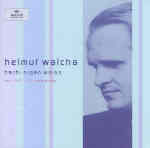Helmut Walcha’s sober, unselfregarding, and uncommonly clear Bach interpretations dominated the German organ school of the 1950s and ’60s, mirroring Otto Klemperer’s similar hold over the German symphonic repertoire. His 1956-71 stereo Bach organ music cycle, though “less complete” than sets containing works of arguable authenticity alongside the real deals (Preston’s Decca cycle, for example), still holds its own as a reference version. Walcha also recorded the Bach cycle in mono, inaugurating DG’s historic Archiv label in 1947 and continuing the project through 1952. These performances are now reissued for the first time together under one roof (if you don’t count an earlier Japanese boxed-set release).
Sonically speaking, they hold up remarkably well for their vintage, although you hear tiny instances of tape warpage or distortion in the upper partials. The major difference between mono and stereo cycles has to do with the instruments and registrations. The 1947 sessions utilize the small organ of St. Jakobi in Lübeck, whose wind and brass stops have a tart, almost nasal quality that contrasts to the smoother, subtler blends characterizing the organ by Saint-Pierre-de-Jeune in Strasbourg heard in the stereo recordings. Similar parallels hold true between the rosy Arp Schnitger organ in Cappel (the mono recordings include Walcha demonstrating its registration, followed by an improvisation) and the clarion brightness of the organ of St. Laurenskerk in Alkmaar (stereo).
As an interpreter, the younger Walcha proves just as consistent and dependable as his older self, commanding a supple, secure technique that allowed no blurred lines or flustered textures. That goes for his feet as well as his hands. To be sure, A/B comparisons yield differing perspectives. Some performances convey more rhythmic propulsion and swing, such as the Trio Sonatas and a particularly exciting D minor Toccata and Fugue (yes, the famous one). Conversely, many chorale preludes (like those contained within the German Organ Mass) and the great C minor Passacaglia and Fugue benefit from subtler registrations and slightly faster, more fluid tempos in the later recordings. And Walcha initially used a harpsichord for the Four Duets BMV 802-5 but reverted to the organ for his remake.
These differences, however, are of no major consequence, and I’d still refer general collectors to the later cycle for its vibrant stereophony and for its inclusion of Walcha’s classic 1956 The Art of Fugue. Although Walcha’s mono Bach will appeal primarily to specialists, DG’s production team deserves high praise for its splendid and honest remastering work.
































